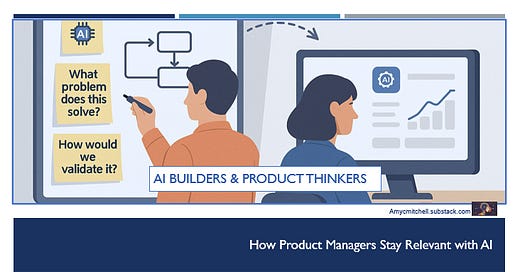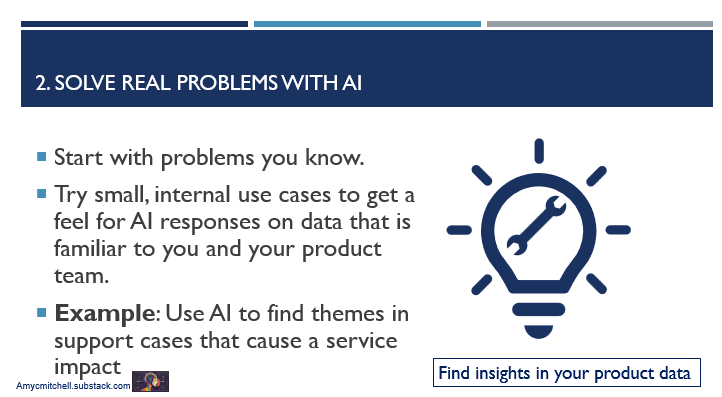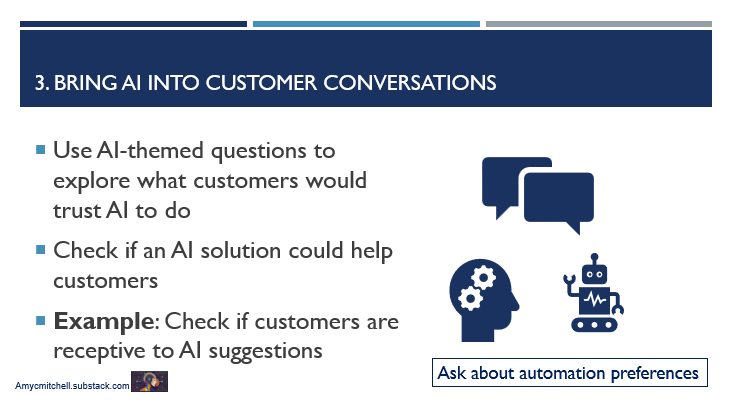AI Builders Get the Hype. Product Thinkers Drive the Value
How product managers can stay relevant - and lead - without building side projects
A wave of “vibe coding” is sweeping through product management circles. Your feed might be full of stories where PMs spin up AI-powered side projects using tools like Replit, Lovable, or Curser. They’re clever, often scrappy, and always end with some version of: “I built this AI agent in a weekend!”
It’s fun to watch—but also easy to feel like you’re falling behind if you’re not shipping your own GPT wrapper or workflow bot. The truth? A lot of this activity is experimentation for experimentation’s sake. These projects reveal interesting engineering challenges, but after the build, their real value to product managers gets murky.
Here’s the good news: you don’t need to be vibe coding to extract insight or stay ahead. In fact, product managers have a unique superpower—product thinking. And that’s exactly what can turn these playful AI demos into something real.
Instead of rushing to build, try applying product thinking to what’s already being shared. Ask:
Who are the users, and does this solve a real problem?
Is it designed for continuous learning and iteration?
Could a cross-functional team scale this into a real product?
If you aren't building something with AI, then how do you stay current and drive the value of AI into your product?
4 Ways to Stay Relevant Without Building an AI Side Project
Product management job descriptions, even at AI companies, look for a product thinker and demonstrated product skills, such as building cross-functional relationships and strong communication skills. Likewise, job descriptions expect technical fluency and domain experience.
To stay current and valuable with AI and product skills, product managers can:
Step 1: Map AI concepts to your product and domain: learn key AI concepts that apply to your product and domain.
Investigate how to use these concepts on repetitive and manual functions in your product.
Repetitive functions: analytics, customer pipeline analysis, churn prevention, upsell opportunities
Manual process improvements: call centers, service desks, customer support
Consider which AI concepts are relevant:
Machine Learning for dynamic data analysis. Includes Large Language Models (LLMs) and Retrieval-Augmented Generation (RAG).
Deep Learning for human-like thinking and pattern recognition
Natural Language Processing (NLP) so AI can understand and generate human language
Computer Vision so AI can analyze and understand images and videos. Including facial recognition.
Get familiar with these concepts. Pick a high-value use case and apply a couple of concepts to your product and domain.
Step 2: Solve real problems with AI: Start with the problems you know best in your product environment.
Typical problems that have been improved with AI are:
Operational efficiency from cost reductions
Decision making
Customer experience
Risk management
Financial performance
An internal use case that solves a nagging problem is a start. You could consider adding a small initiative to a new product or service introduction to build something with AI.
Some examples of problems to consider are:
Finding themes in support cases that cause a service impact
Evaluating orders for use case patterns in prioritizing release packaging
Website analytics for trends in product usage
You can get a feel for AI responses on data that is familiar to you and your product team.
Step 3: Bring AI into your customer conversations: Understand your customer's perspective on AI.
This is your opportunity to bridge what your customer needs and potential product capabilities. This gives you a chance to check if an AI solution could actually help customers. Likewise, you can bring real customer concerns back to your team for building AI solutions.
Some example customer conversation questions:
Where do you feel like you're doing repetitive work with the product (or feature)?
➡️Hearing about the customer's struggles with repetitive actions gives you insights for possible AI solutions.
Would you trust the product to do this step for you, or would you want to review it first?
➡️Helps you get feel about applying an AI solution or extra checks with the customer on a possible AI solution.
How would you feel if the product made a recommendation instead of you deciding?
➡️Checks if the customer is receptive to AI suggestions or if suggestions would frustrate the customer.
These customer conversations allow you to collaborate with your product team on potential AI solutions. And you gather key information on your customers' expectations for possible AI solutions.
Step 4: Run AI experiments inside your product management process: Get time savings on product management effort with AI.
Basic AI tools can reduce the amount of effort in:
Research on new features and requirements
Communication to stakeholders
Feedback on potential outbound messaging in early stages
Some examples of product manager usage are:
Summarize customer feedback to find patterns faster
Simulate a customer persona for feedback on product plans
Check if early messaging would interest potential customers
Simulate a stakeholder for an upcoming presentation
Summarize the key talking points for the next stakeholder update
These experiments help product managers stay current on AI solutions.
You can also continue validating that your product and product team are ready for AI in your product.
Conclusion: Different Paths, Same Goal—Driving Real Value with AI
Vibe coding and AI side projects are great ways for product managers to explore what’s possible. If that energizes you—keep building. You’ll learn a ton, fast.
But if you're not coding, don’t count yourself out. Applying product thinking to AI opportunities in your day-to-day work is just as powerful. Mapping concepts, testing small experiments, and bringing AI into real customer conversations—that’s how you drive actual outcomes.
Vibe coders build to learn. Product thinkers learn to build value.
Whichever path you choose, the goal is the same: use AI to make better products, faster. And that’s something every PM can contribute to.
References:
AI Readiness Checklist: Make sure your product is ready to thrive in the AI-driven future.
AI ROI Report: A recent survey by Snowflake on cost savings from AI solutions
Last week’s backstory for paid subscribers was about handling nagging product issues without slowing down. What Happened to the Cracks Beneath the Surface?
Paid subscribers get access to 12+ templates and quick start guides.🎁
TLDR Product listed Product Management IRL articles recently! This biweekly email provides a consolidated list of recent product management articles.
Check out Product Management Free Resources for free product management resources.
Connect with Amy on LinkedIn, Threads, Instagram, and Bluesky for product management insights daily.









Dean’s Smokejumper Survival Guide for AI Product Management Initiatives
- Remain calm and focus on the problem space.
- Feel their pains and learn their gains.
- Decode the data reality before you hallucinate solutions.
- Know what AI playing field you’ve picked.
- Unpack unknowns before they unpack your timeline.
- Optimize your product ops with prompt engineering, not more meetings.
- Build on tiny bets, not Titanic assumptions.
- Scale smartly—start with cohorts, not chaos.
- Socialize an outcomes blueprint people can actually follow.
> If you’re not sweating a little, it’s not product management—it’s cosplay.
YMMV
Vibe coding is the best! And according to the dev team...also the worst. We're going to split the difference on this one.